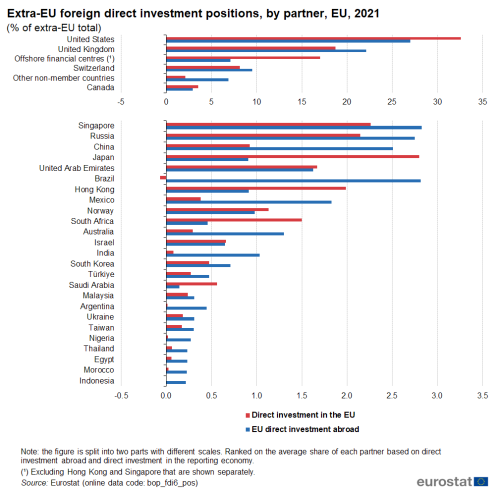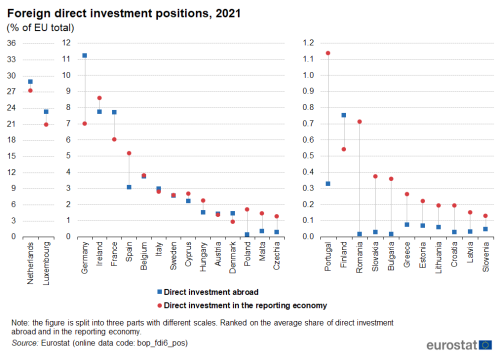Foreign direct investment - stocks
Data extracted in July and August 2023.
Planned article update: August 2024.
Highlights
At the end of 2021, the United States and the United Kingdom were the main locations for the EU's outward FDI stocks and were also the principal inward investors in the EU, along with offshore financial centres.
The Netherlands and Luxembourg together held approximately half of all the EU's FDI stocks at the end of 2021, for inward and outward stocks.

(% of extra-EU total)
Source: Eurostat (bop_fdi6_pos)
Globalisation patterns in EU trade and investment is an online Eurostat publication presenting a summary of recent European Union (EU) statistics on economic aspects of globalisation, focusing on patterns of EU trade and investment.
In a globalised economy, enterprises can make investments abroad to establish a commercial/territorial presence in foreign markets, for example, by founding hotel or retail chains. Within the General Agreement on Trade in Services (GATS), this type of trade in services is referred to as mode 3 (the supply of international services).
Foreign direct investment (FDI) stocks (or positions) measure the total value of direct investment at a given point in time; the statistics presented in this article focus on stocks as measured at the end of the year.
The analyses of investment by partner are based on a fixed list of countries: Argentina, Australia, Brazil, Canada, China, Egypt, Hong Kong, India, Indonesia, Israel, Japan, Malaysia, Mexico, Morocco, Nigeria, Norway, Russia, Saudi Arabia, Singapore, South Africa, South Korea, Switzerland, Taiwan, Thailand, Türkiye, Ukraine, the United Arab Emirates, the United Kingdom and the United States, as well as offshore financial centres. Note that information for Hong Kong and Singapore is shown separately and hence these two countries are excluded from the offshore financial centres aggregate in this article (to avoid double-counting).
The various analyses presented below – by partner country, by activity and for EU Member States – are based on the latest data available: for the analysis by partner country and by EU Member State, the most recent reference period is 2021; for the analysis by activity, the latest period is either 2019 or 2020. FDI stocks for 2021 may differ from 2019 or 2020, in part due to the impact of the COVID-19 pandemic.
Furthermore, the analyses by partner country and by activity are for the EU's FDI stocks with non-member countries (also referred to as extra-EU stocks). The analyses for EU Member States include not only such extra-EU stocks but also stocks of FDI between EU Member States (also referred to as intra-EU stocks).
Full article
EU's inward and outward investment by partner
At the end of 2021, the United States and the United Kingdom were the main locations for the EU's outward FDI stocks …
Comparing the EU's positions for inward and outward investment, inward investment appears to be somewhat more concentrated in the hands of a relatively small number of developed economies; the EU's outward stock of FDI was somewhat more widely distributed, including several developed and emerging economies (see Figure 1). For example, while China accounted for a 0.9 % share of inward FDI positions in the EU economy, about 2.5 % of the EU's outward stocks of FDI were held in China. A similar difference was observed for the United Kingdom, Brazil, Mexico, Switzerland, Australia, India, Russia and Singapore.
At the end of 2021, the United States had the biggest share (27.0 %) of the EU's FDI stocks abroad, valued at €2.5 trillion (or €2 500 billion); the second largest partner was the United Kingdom (22.1 %), with Switzerland the third largest (9.5 %). Offshore financial centres (excluding Hong Kong and Singapore) had the fourth largest share (7.1 %) of the EU's outward stocks of FDI at the end of 2021. Among the selected partner countries, Asian economies together accounted for 11.7 % of the EU total (principally Singapore, China, the United Arab Emirates, India, Hong Kong, Japan and South Korea).
… and were also the largest inward investors in the EU
At the end of 2021, the United States held close to one third (32.6 %) of the inward investment in the EU from the rest of the world. The United States maintained its position as the major holder of FDI stocks in the EU. The United Kingdom (18.7 %) and offshore financial centres (17.0 %) were the next largest holders of FDI in the EU in 2021. A majority of the stocks of FDI in the EU held by offshore financial centres were held by investors registered in Bermuda, the Cayman Islands, Jersey, the British Virgin Islands and Gibraltar.

(% of extra-EU total)
Source: Eurostat (bop_fdi6_pos)
EU's inward and outward investment by activity
FDI stocks were concentrated in the services sector
An analysis of the EU's international investment position at the end of 2020 reveals that the services sector (excluding health, education, arts, entertainment and recreation) – defined here as financial and insurance activities, professional, scientific and technical activities, distributive trades, information and communication, administrative and support service activities, real estate activities, transportation and storage, accommodation and food service activities – accounted for 69.5 % of the EU's outward investment positions (direct investment abroad).
Inward FDI positions held in the EU at the end of 2020 for financial and insurance activities were valued at €4 800 billion
The activity structure of the EU's FDI positions was dominated by financial and insurance activities (for which it had a deficit, with greater investment in the EU than abroad), and by manufacturing (which had a positive balance, with higher stocks of outward rather than inward investment). Most other service and non-service activities also registered a positive balance (with higher levels of EU direct investment abroad). The EU's outward position in financial and insurance activities was valued at €4 200 billion, which was close to half (48.7 %) of the total for all outward positions; the EU's inward position in this activity was valued at €4 800 billion (see Figure 2). Manufacturing was the second largest activity by these measures, with the EU's outward position valued at €2 100 billion and the inward position valued at €1 000 billion.

(€ billion)
Source: Eurostat (bop_fdi6_pos)
Figure 3 presents a more detailed analysis of the FDI positions abroad within manufacturing. It shows that, at the end of 2020, a majority of the EU's outward stocks of FDI within manufacturing were held in the following activities: pharmaceuticals, coke and refined petroleum products, chemicals, and food, beverages and tobacco [1]. It is also interesting to note that textiles and clothing accounted for one of the lowest shares of the EU's outward stock of FDI in manufacturing activities (1.3 %); this may suggest that enterprises involved in the manufacture of these goods resorted to alternative forms of industrial organisation (for example, outsourcing or subcontracting).

(% of manufacturing total)
Source: Eurostat (bop_fdi6_pos)
FDI positions in the EU Member States
The Netherlands and Luxembourg together held around half of all the EU's FDI stocks at the end of 2021
Figure 4 presents the inward and outward FDI positions of the EU Member States; note the information presented includes not only stocks of FDI held in non-member countries but also stocks in other Member States. At the end of 2021, the Netherlands and Luxemburg both accounted for very high shares of the total inward and outward investment positions of the Member States. Indeed, the Netherlands (28.9 %) and Luxembourg (23.3 %) together held more than half of the outward stock of FDI; they were followed by Germany (11.2 %).
The pattern for inward investment positions was quite similar, as the Netherlands (27.2 %) and Luxembourg (20.9 %) again held close to half of the inward FDI positions of the EU Member States at the end of 2021, followed by Ireland (8.6 %). These high shares likely reflect the considerable stock of investment that is held in investment funds and holding companies in all three of these EU Member States.
Germany had 11.2 % of the outward FDI positions at the end of 2021, which could be contrasted with its 7.0 % share of the inward investment positions; it was a net investor as it had a higher stock of FDI abroad compared with the level of inward FDI that was held in the German economy. A similar pattern was observed for France, which held 7.7 % of the outward positions, some 1.7 percentage points higher than its share of inward investment. The other EU Member States which were net investors as of the end of 2021 were Luxembourg, the Netherlands, Denmark, Finland, Italy and Austria.
Source data for tables and graphs
Direct access to
Notes
- ↑ Note that the ranking by activity for stocks of direct investment abroad is of lower quality than comparable information pertaining to inward stocks as not all of the EU Member States are able to provide a breakdown of their FDI according to the activity of non-resident enterprises.
- Balance of payments – International transactions (BPM6) (bop_6), see:
- European Union direct investments (BPM6) (bop_fdi6)
Metadata
- Balance of payments – international transactions (BPM6) (ESMS metadata file – bop_6_esms)
- European Union direct investments (BPM6) (ESMS metadata file – bop_fdi6_esms)
Further methodological information
